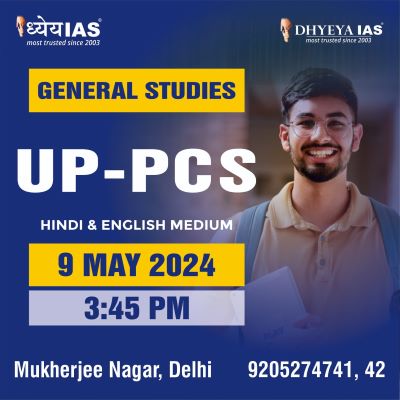Syllabus: Paper-II: General Studies - I (Indian Heritage and Culture, History and Geography of the World and Society)
1. Urbanization – problems and remedies
Relevant Data from Census 2011
| Total Urban Population | 377 million |
| Rate of growth of urban population | 2.76% per annum during 2001-2011 In 2001-11 the urban population grew by 31.8 per cent |
| Percentage of Urban Population | 31.1% |
| Most Urbanized state | Goa (62%), Mizoram, Tamil Nadu |
| Least Urbanized state | Himachal Pradesh (10%) followed by Bihar, Assam and Odhisa |
Projections by 2030
- As per the UN’s projections, India’s share in the world’s urban population will rise to 13 per cent by 2030.
- By 2030, India’s urban population is set to reach 590 million, an addition of approximately 300 million to India’s current urban population.
- Making smart cities inclusive is also consistent with Goal 11 of the Sustainable Development Goals (SDGs).
Facts
- About 43 percent of the urban population of India lives in cities with population of 1 million or more.
- The bulk of urban Indians — 181 million or 50% — stay in small towns with less than half a million (5 lakh) population
- About 17.4% of India’s urban population lives in slums.
- 2.9% of urban houses are in a dilapidated condition according to Census 2011.
- Delhi is 4-12°C warmer due to the urban heat island effect.
- Urban areas contribute 70% to the GDP but occupy only 4% of the land base
- The number of Indian urban agglomerations with more than one million people has grown by more than 50 per cent over one decade alone, to 53 (the 2011 Census).
Reports:
- Hidden Urbanisation by World Bank : According to a 2015 World Bank report, the urban sprawl accounts for 55.3 percent of the country’s total population and that official census figures understate it as only 31 percent- ‘Hidden Population’
- Delhi is projected to become world’s Most populous city around 2028 - UN Report
Schemes
- “Housing for all by 2022” - Pradhan Mantri Awas Yojana anchor scheme
- PMAY envisages building 20 million urban units by 2022
- 17% of the houses constructed under centrally sponsored schemes were vacant in 2017 because of poor relocation planning and missing infrastructure.
Children in cities
- More than 3.6 crore children (in the age group of 0 to 6 years) live in urban areas, of whom at least 81 lakh (22.5%) live in slums.
- According to Save the Children’s recent report, ‘Life on the Street’, there are well over 20 lakh children on the streets of India.
Public Transport
- Infrastructure investment was Rs. 31.6 per car trip while that for a bus user was Rs. 0.90 per trip.
- A KPMG study published last year forecasts that an additional 6 lakh buses are needed to achieve 50% of all urban transport trips by public modes by 2031, at the present level of ridership per bus.
- By shifting to electric vehicles India could save 64 per cent energy in 2030 by shifting to shared electric mobility.
Urban Governance
Urban Governance (ANNUAL SURVEY OF INDIA’S CITY-SYSTEMS (ASICS), 2017 Report
- Pune (score 5.1) topped the survey while Bengaluru (3) was ranked the lowest in the list. Comparatively, global benchmarks of Johannesburg, London and New York have scored 7.6, 8.8 and 8.8 respectively whereas Indian cities have barely touched 5.1 (being highest).
- Only 9 of the 23 cities had a citizen’s charter.
- 19 of the 23 cities don’t release even basic data about their functioning in usable formats.
- The lack of a modern, contemporary urban planning framework may be costing India 3% of its GDP every year.
Credit Worthiness of Indian city
- Agencies such as CRISIL rated 94 cities which are part of Smart City Mission and Atal Mission for Rejuvenation and Urban Transformation (AMRUT). Out of 94, 55 cities got investment grade rating (BBB- and above), while other 39 were rated below BBB-
- Thirteenth finance Commission data reflected that the municipal tax to GDP ratio is a meagre 0.5 per cent as compared to central tax to GDP ratio at 12 per cent.























